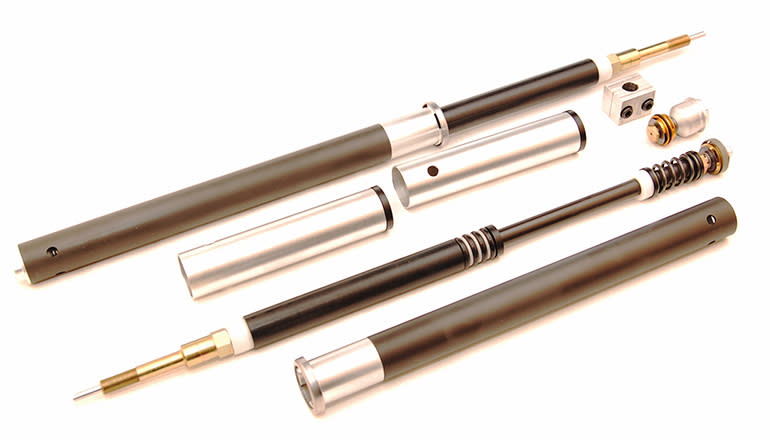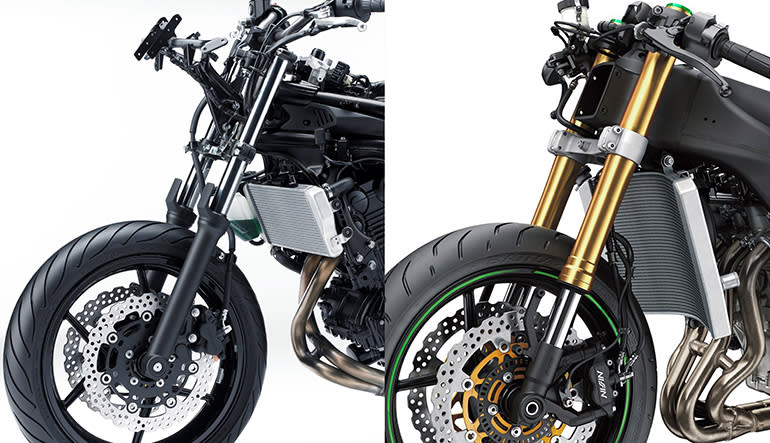The Basics: Modern Motorcycle Suspension
In it's simplest design, suspension was not invented (on motorcycles or cars) for the sheer purpose of comfort, but more for safety and going fast. A mutual problem between all the big-named competitors—that is always improved, but never fully solved—is keeping the rubber on the road. A well functioning suspension should absorb the shock of paved imperfections while increasing cornering, braking and acceleration thresholds, but how did it modern suspension evolve into what we're riding today? We take a look at motorcycle suspension, explaining the basics and its evolution.
Modern Motorcycle Suspension
Suspension is the component that allows the wheels to move up and over its impeding obstacle, and it also strives to eliminate traction loss and the transfer of kinetic energy past itself. During the developmental years of the motorcycle, fabricators experimented with multiple ways to accomplish this. Mirroring the evolutionary sequence, the process of elimination has narrowed the average setup to forks for the front wheel and a swingarm for the rear wheel.
READ MORE: How To: Not be a Noob at a Track Day | RideApart

Because the front wheel is the steering control of a motorcycle, nearly every motorcycle today has a pair of telescopic forks. Forks are basically large shock absorbers with an internal spring and hydraulic damper. They are held in place by a set of triple trees that turn at the steering neck. (For the sake of this discussion, we are excluding some of the rare designs like the Earles fork or Telelever fork that uses a swingarm in the front as well as in the rear.)
A swingarm is the main component of the rear suspension and it pivots on one end and holds the axle perpendicular to the other end—all regulated by one or two shock absorbers. Although most motorcycles have a similar front end, swingarm designs tend to vary between motorcycles. Before the 1970's, most motorcycles incorporated two shock absorbers on opposing sides of the wheel until the benefits of a monoshock swingarm came to fruitio.

What Wins on Sunday, Sells on Monday
The first official season of MotoGP in 1949 introduced many different types of front suspension into competition. The winner of the premier 500cc class, Leslie Graham rode a telescoping fork-equipped AJS. Most two wheeled races placed fork-wielding machines past the finish line first, and it didn’t take long for the competitors to catch on. Through the next few championships, most racing teams chose to iron out the creases of telescoping forks rather than doing so with other inferior alternatives.

Spring preload—or the amount of force applied by the internal spring before compression—was set by installing a spacer at one end of the spring. When the fork compresses, a check valve allows the fork oil to travel through a small hole called the “compression orifice." Decompression of the forks is controlled by the rebound damping orifice, which regulates the speed the forks will return.
READ MORE: Tales From A Noob: Because Mom Can't Say No | RideApart
Because the internals of telescoping forks were altered to meet the demands of differing track and bike combinations, the need for an easier universal fitment arose—enter the invention of adjustable suspension. Threads were tapped onto the spring preload spacer, and damping orifices could be throttled with valves. The best part is that these adjustments could be made without the arduous task of disassembling the forks.

While these are both cut-aways of brand new motorcycles, the best performing suspension typically uses inverted forks (pictured right).
Around the same time that big hair was being cut down and frosted tips became popular, the genius engineers of suspension found that inverting a motorcycle's forks proved to be far more beneficial than the standard way of mounting. With upside-down (USD) forks, the outer tube was now affixed to the triple trees, and the lighter inner tube moved with the wheel. This made for a more rapid shock absorption, while improving the rigidity of the whole assembly…CONTINUE READING
CONTINUE READING: For an explanation of rear motorcycle suspension development and the conclusion of our first Basics installment

 Yahoo Autos
Yahoo Autos 
